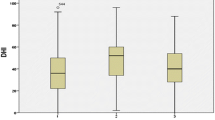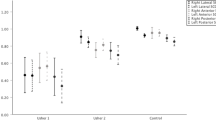Abstract
This study aimed to determine the incidence, pattern, and etiology of dissociated vestibulo-ocular reflex (VOR) function according to the stimulus frequency in dizzy patients. We retrospectively evaluated the results of bithermal caloric tests and video-head impulse tests (vHITs) in 1022 patients with dizziness or vertigo between July 2016 and April 2021. Patients were classified into concordant group (normal or abnormal results on both tests) and discordant group (dissociated results between two tests). Of 1022 patients, discordant group had 159 (16%), comprising abnormal horizontal vHITs with normal caloric responses (n = 36, 23%) and abnormal caloric tests with normal horizontal vHITs (n = 123, 77%). The former group showed similar frequency of peripheral (44%) and central (42%) causes, and more common involvement of bilateral horizontal semicircular canals in central than peripheral causes (86.7 vs 37.5%, p = 0.005). The most common peripheral causes were Meniere’s disease and chronic vestibular neuritis, while central causes were variable, but mainly affecting the cerebellum. In the latter group, peripheral causes were common (67%), with the main etiologies being Meniere’s disease and vestibular neuritis, whereas central causes were found in only 5%. The degree of canal paresis did not differ significantly between patients with central and peripheral causes. Discordant VOR function according to the stimulus frequency was not uncommon in dizzy patients. Specific patterns of VOR dissociation according to the disease etiologies may offer insight into underlying pathophysiology.




Similar content being viewed by others
References
Leigh RJ, Zee DS (2015) The neurology of eye movements, 5th edn. Oxford University Press, New York
Lisberger SG, Miles FA, Zee DS (1984) Signals used to compute errors in monkey vestibuloocular reflex: possible role of flocculus. J Neurophysiol 52:1140–1153
Shepard NT, Jacobson GP (2016) The caloric irrigation test. Handb Clin Neurol 137:119–131
Halmagyi GM, Chen L, MacDougall HG, Weber KP, McGarvie LA, Curthoys IS (2017) The video head impulse test. Front Neurol 8:258
Hannigan IP, Welgampola MS, Watson SRD (2021) Dissociation of caloric and head impulse tests: a marker of Meniere’s disease. J Neurol 268:431–439
Lee JY, Kwon E, Kim HJ et al (2020) Dissociated results between caloric and video head impulse tests in dizziness: prevalence, pattern, lesion location, and etiology. J Clin Neurol 16:277–284
Blödow A, Heinze M, Bloching MB, von Brevern M, Radtke A, Lempert T (2014) Caloric stimulation and video-head impulse testing in Ménière’s disease and vestibular migraine. Acta Otolaryngol 134:1239–1244
McGarvie LA, Curthoys IS, MacDougall HG, Halmagyi GM (2015) What does the dissociation between the results of video head impulse versus caloric testing reveal about the vestibular dysfunction in Meniere’s disease? Acta Otolaryngol 135:859–865
Lee SU, Kim HJ, Koo JW, Kim JS (2017) Comparison of caloric and head-impulse tests during the attacks of Meniere’s disease. Laryngoscope 127:702–708
Zellhuber S, Mahringer A, Rambold HA (2014) Relation of video-head-impulse test and caloric irrigation: a study on the recovery in unilateral vestibular neuritis. Eur Arch Otorhinolaryngol 271:2375–2383
Magliulo G, Iannella G, Gagliardi S, Re M (2015) A 1-year follow-up study with c-VEMPs, o-VEMPs and video head impulse testing in vestibular neuritis. Eur Arch Otorhinolaryngol 272:3277–3281
Bartolomeo M, Biboulet R, Pierre G, Mondain M, Uziel A, Venail F (2014) Value of the video head impulse test in assessing vestibular deficits following vestibular neuritis. Eur Arch Otorhinolaryngol 271:681–688
Jung J, Suh MJ, Kim SH (2017) Discrepancies between video head impulse and caloric tests in patients with enlarged vestibular aqueduct. Laryngoscope 127:921–926
Kim JS, Kim HJ (2012) Inferior vestibular neuritis. J Neurol 259:1553–1560
Lopez-Escamez JA, Carey J, Chung WH et al (2015) Diagnostic criteria for Meniere’s disease. J Vestib Res 25:1–7
Lempert T, Olesen J, Furman J et al (2012) Vestibular migraine: diagnostic criteria. J Vestib Res 22:167–172
Strupp M, Kim JS, Murofushi T et al (2017) Bilateral vestibulopathy: diagnostic criteria consensus document of the Classi-cation Committee of the Bárány Society. J Vestib Res 27:177–189
Strupp M, Lopez-Escamez JA, Kim JS et al (2016) Vestibular paroxysmia: diagnostic criteria. J Vestib Res 26:409–415
Staab JP, Eckhardt-Henn A, Horii A et al (2017) Diagnostic criteria for persistent postural-perceptual dizziness (PPPD): consensus document of the committee for the classification of vestibular disorders of the Bárány society. J Vestib Res 27:191–208
Strupp M, Bisdorff A, Furman J, et al (2021) Acute unilateral vestibulopathy/vestibular neuritis: diagnostic criteria: consensus document of the committee for the classification of vestibular disorders of the Bárány society. J Vestib Res. In press
Slater R (1979) Benign recurrent vertigo. J Neurol Neurosurg Psychiatry 42:363–367
Dlugaiczyk J, Lempert T, Lopez-Escamez JA, Teggi R, von Brevern M, Bisdorff A (2021) Recurrent vestibular symptoms not otherwise specified: clinical characteristics compared with vestibular migraine and Menière’s disease. Front Neurol 12:674092
Lee SU, Choi JY, Kim HJ, Kim JS (2018) Recurrent spontaneous vertigo with interictal headshaking nystagmus. Neurology 90:e2135–e2145
Oh EH, Shin JH, Cho JW, Choi SY, Choi KD, Choi JH (2021) Episodic vestibular syndrome with hyperventilation-induced downbeat nystagmus. Cerebellum 20:796–803
Fujita H, Kitahara T, Koizumi T, Ito T, Inui H, Kakudo M (2021) Investigation of endolymphatic hydrops positivity rates in patients with recurrent audiovestibular symptoms using inner ear magnetic resonance imaging. Auris Nasus Larynx. In press
Lee SU, Kim JS, Kim HJ et al (2020) Evolution of the vestibular function during head impulses in spinocerebellar ataxia type 6. J Neurol 267:1672–1678
Choi JH, Oh EH, Choi SY, et al (2021) Vestibular impairments in episodic ataxia type 2. J Neurol. In press
Stahl JS, Simpson JI (1995) Dynamics of rabbit vestibular nucleus neurons and the influence of the flocculus. J Neurophysiol 73:1396–1413
Park HK, Kim JS, Strupp M, Zee DS (2013) Isolated floccular infarction: impaired vestibular responses to horizontal head impulse. J Neurol 260:1576–1582
Allum JH, Cleworth T, Honegger F (2016) Recovery of vestibulo-ocular peflex symmetry after an acute unilateral peripheral vestibular deficit: time course and correlation with canal paresis. Otol Neurotol 37:772–780
Tarnutzer AA, Bockisch CJ, Buffone E, Weber KP (2017) Association of posterior semicircular canal hypofunction on video-head-impulse testing with other vestibulo-cochlear deficits. Clin Neurophysiol 128:1532–1541
Lerchundi F, Laffue AH, Olivier M, Gualtieri FJ (2020) Bilateral posterior semicircular canal dysfunction: a new finding with video head impulse test. J Neurol 267:2347–2352
Guerra Jimenez G, Perez FN (2016) Reduction in posterior semicircular canal gain by age in video head impulse testing. Observational study. Acta Otorrinolaringol Esp 67:15–22
Author information
Authors and Affiliations
Contributions
Dr. HSK analyzed and interpreted the data and wrote the manuscript. Drs. EHO, JYK, SYC, and KDC analyzed and interpreted the data. Dr. JHC designed and conceptualized the study, interpreted the data, and revised the manuscript.
Corresponding author
Ethics declarations
Conflicts of interest
All authors report no disclosures.
Ethical approval
This study followed the tenets of the Declaration of Helsinki, and was approved by the Institutional Review Boards of Pusan National University Yangsan Hospital (05-2022-017).
Rights and permissions
About this article
Cite this article
Kim, H.S., Oh, E.H., Kim, JY. et al. Discordant vestibulo-ocular reflex function according to the frequency and mode of stimulation. J Neurol 269, 4742–4752 (2022). https://doi.org/10.1007/s00415-022-11105-y
Received:
Revised:
Accepted:
Published:
Issue Date:
DOI: https://doi.org/10.1007/s00415-022-11105-y




